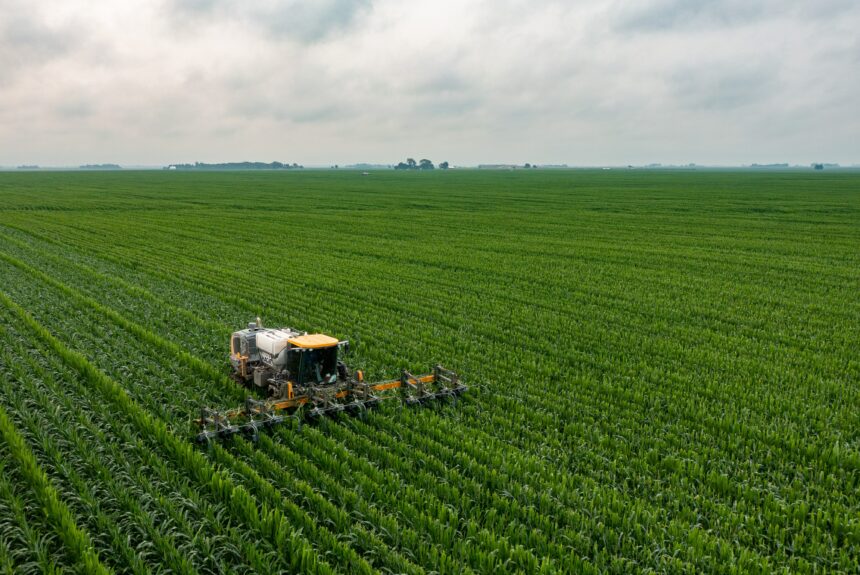The Challenge: Farmers and ranchers are on the front lines as the climate changes. Warming affects crop seasons, soil nutrition, and erosion. Extreme weather such as droughts, heat waves, and floods can ruin crops. Land-use changes, production, livestock management, fertilizer use, and transportation increase carbon dioxide, methane, and nitrous oxide emissions.
The Opportunity: American farmers and ranchers are essential to putting safe, secure food on the table for families in the United States and around the world. The 2023 Farm Bill provides an opportunity to invest in and advance America’s agricultural sector. By investing in new technologies, inventing new techniques, and identifying cost savings, farmers and ranchers have dramatically improved their efficiency. They are producing more crops with fewer inputs. Continued innovation can drive efficiency, increase output, reduce emissions, and maintain American and global leadership in agriculture.
The Solutions: To increase food supplies for American families, boost incomes for American farmers and ranchers, and improve the environment in the farm bill and beyond, Congress and the administration should:
- Commit to basic and applied research at the Department of Agriculture. Key programs to fund include the Agriculture Advanced Research and Development Authority, The Foundation for Food Agriculture Research, and biochar programs.
- Expand opportunities for regenerative agriculture.
- Make immediate expensing permanently available.
- Maximize the efficiency of rural broadband spending.
- Adopt a technology-neutral approach to USDA energy programs.
- Identify goals, metrics, and assessment processes to measure the effectiveness of conservation programs.
- Reform permitting for invasive species plans to efficiently utilize federal spending for invasive species prevention, early detection systems, and eradication.
- Expand the use of incentives to reduce invasive species.
Key Facts
- The global food system represents 21 to 37 percent of annual emissions (as measured by 100-year Global Warming Potential).
- Since 1948, America’s farmers have tripled their output, while using 75% less labor and 24% less land.
- Public funding levels for agricultural R&D have fallen by a third over the past two decades. After adjusting for inflation, it is at the same level as in 1970.
- From 1990 to 2011, every $1 spent on federal agriculture R&D yielded $20 in benefits to the U.S. economy.
Legislation to follow:
|
Legislation |
Bill Number(s) |
House Sponsor |
Senate Sponsor |
House Cosponsor(s) |
Senate Cosponsor(s) |
|
Advancing Cutting Edge (ACE) Agriculture Act of 2023 |
Bennet (D-CO) |
Marshall (R-KS) |
|||
|
Biochar Research Network Act of 2023 |
Grassley (R-IA) |
Tester (D-MT), Thune (R-SC), Brown (D-OH) |
|||
|
Conservation and Innovative Climate Partnership Act of 2023 |
Newhouse (R-WA-4) |
Thune (R-SD) |
Pingree (D-ME-1) |
Smith (D-MN), Braun (R-IN), Schatz (D-HI) |
|
|
Conservation Reserve Program Improvement Act of 2023 |
Thune (R-SD) |
Klobuchar (D-MN) |
|||
|
Emergency Conservation Program Improvement Act of 2023 |
Fischer (R-NE) |
Lujan (D-NM) |
|||
|
EQIP Improvement Act of 2023 |
Booker (D-NJ) |
Lee (R-UT) |
|||
|
Food and Agriculture Industry Cybersecurity Support Act |
Pfluger (R-TX-11) |
Veasey (D-TX-33), Curtis (R-UT-3), Matsui (D-CA-7) |
|||
|
Precision Agriculture Loan Program Act of 2023 |
Feenstra (R-IA-4) |
Fisher (R-NE) |
Panetta (D-CA-19), Tokuda (D-HI-2), Thompson (D-CA-2), Guest (R-MS-4) |
Klobuchar (D-MN) |
|
|
Precision Agriculture Satellite Connectivity Act |
H.R.1339 |
Latta (R-OH-5) |
Kelley (D-IL-2) |
||
|
Producing Responsible Energy and Conservation Incentives and Solutions for the Environment (PRECISE) Act |
Hinson (R-IA-2) |
Fisher (R-NE) |
Panetta (D-CA-19), Finstad (R-MN-1), Craig (D-MN-2) |
Klobuchar (D-MN) |
Read the full chapter here.


